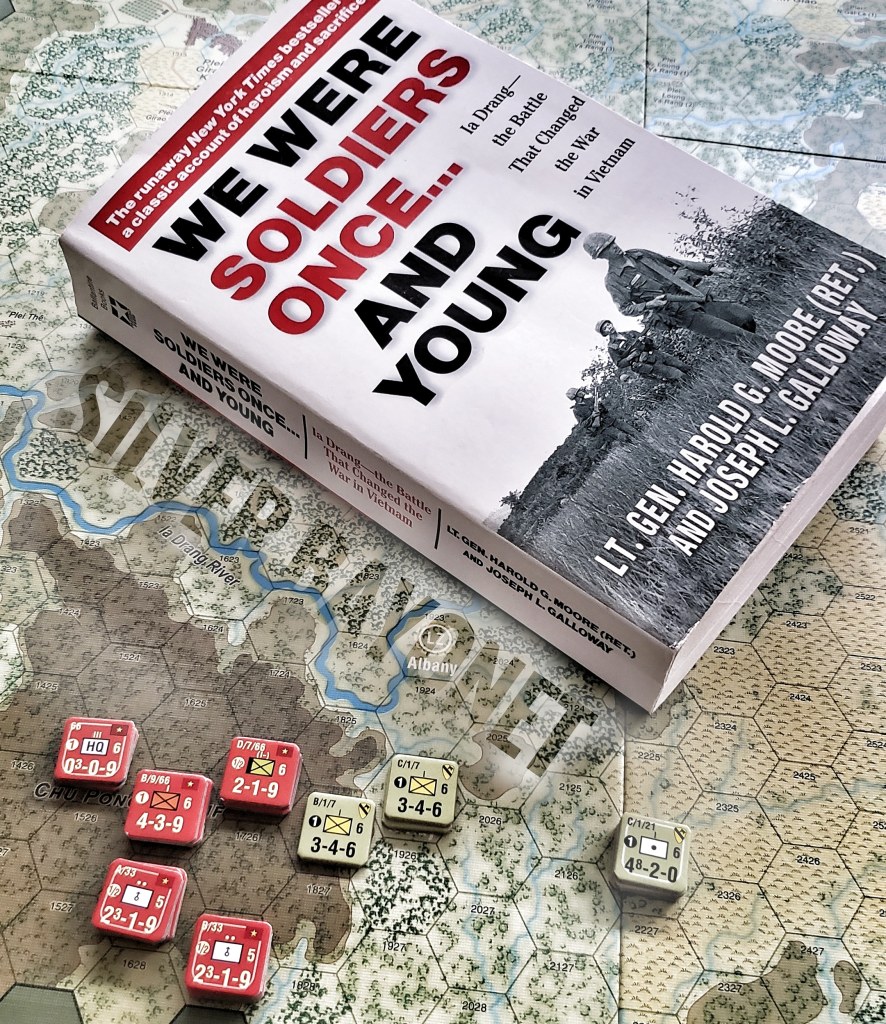




I feel bad for some time now that I haven’t been more prolific on this site recently. And I started spiraling down a very ugly path where I put myself under pressure to produce content and then got very anxious when I didn’t live up to those plans.
It’s not that I don’t want to write anything or that I have nothing to say. There’s actually plenty to talk about: the new version of the GOSS rules, wargamers and wargame designers in Brazil, BCS for beginners, GTS vs CSS, etc.
But the current situation in Brazil is draining a lot of my energy. My family and I are stuck at home for six months now. And while politicians are trying to tell us that it’s actually not so bad and that we should go back to normal, the daily statistics tell a different story. The country gave up its fight against Covid-19 and everyone is now counting on a vaccine. Until then we will have to take matters in our own hands.
And don’t get me wrong, I’m well aware that my family and I live a very privelegd life compared to other Brazilians. Unlike many my wife and I can work from home. And we can afford to have anything we need to be delivered to our place. But between home office and home schooling (Public schools do not necessarily offer online classes since not all families can afford a dependable internet access let alone a computer.) it’s not easy to find a moment to relax, to play a game, or to read a book. I’m very restless, have problems to focus and I’m constantly exhausted.
I’m in awe by the amount of content created on other sites, but I’m sure I’m not the only one struggling with the situation.
Maybe this little excursion helps explaining that there hasn’t been a regular stream of new articles on this site recently. But it will continue and I’ll find back into a new rhythm of regular updates!
Stay safe!
Carsten
A few months ago Keith from @wargamehq interviewed me for his Hexy Talk podcast. The interview was released today. If you are interested in the ramblings of a wargame newbie go check it out. But even if you’re not interested listening to me talking, you should definitely listen to all the other amazing interviews!
Thanks a lot, Keith! It’s been a fun experience.
It’s been a while since my last post. Times are crazy. I hope that with a little bit more time now in June I can get back to a more regular posting schedule.
And I will start with something I have never done before: a wargame review. Well, it started as a review, and then turned into a preview, and possibly back into a review. But see for yourself…
You like tactical-scale wargames? You are interested in cold war era battles? Maybe you would like to play out a hypothetical NATO conflict? Or you are eager to take a closer look at the Indo-Pakistani conflict? Have you ever wondered how a group of Russian marine units would play? What if I told you there’s a wargame system that covers basically any sort of cold war conflict on a tactical scale. The Obscure Battles system, a two-player conflict simulation, lets you do all this and then some.
A few months ago I was asked if I’d be interested to review a game: Obscure Battles. I felt very flattered and agreed right away, only to realize that I actually had never done something like that and regretted my boldness right away. But then I told myself, what the heck, how hard can it be? Well, it turns out, it can be quite hard. Especially in times of COVID19.
I received the files for a PnP version of the game shortly after I agreed to do the review. With a super busy work schedule I had no chance to get to the review until some time later…
It’s now mid March, COVID19 has arrived, classes are canceled, I can work at home. If this is not the right moment to learn a new game, then when is it? Well, the city where I live announces to close down everything. And I don’t really care that much because we can still shop for groceries online and Hair and Nail Salons are not essential for. But then it dawns on me that when the city closes everything, it closes everything. And of course the print shop where I had planned to print the game is closed as well (And before you ask, I have no printer at home because I had brought mine to the office earlier this year and I cant get to the office.).
So how do you review a game that you can’t play? Well, you don’t. All I can do right now is to introduce the game system by commenting on the rules. So in that sense, this article is more of a preview rather than a review.
Fast forward to June. My preview is ready to be posted when the mayor decides to re-open businesses (A decision certainly not based on facts and science.). And my print shop should open as well during the next few weeks. Hm, that’s an unfortunate timing. While I don’t want to delay the article any further, I’m eager to play Obscure Battles before I actually give you my opinion.
OK, here is what I’m going to do: I will split the preview. We will start with a game overview today. I will try to get the game printed in the next days and the second part contains then hopefully some impressions from the actual game play.
I have sent a few questions to one of the game designers, Freman Goldbo, and I will sprinkle them into the text wherever I think they fit.
Gringogamer: Tell us about you and your wargaming background?
Freman Goldbo: Well, I am a geek in his late 40s. Player of wargames since I was 7, I can proudly say I was able to distinguish a Panzer Mark IIIH from a J model when I was 10 ! ( it is really easy btw ). I like to watch A Bridge Too Far to when I drink my hot cocoa. That is who I am really.
I met my first board game when I was 9. It was Hunt The Bismarck! I remember sleeping with the manuals. I lived in a rural Seaside town where such games were hard to come by so I had to beg every person going abroad for a game. I got some second hand AH titles from a friend and patched the map and designed the missing counters. It was like that for me in those days. It continued like that from that time on – even with the coming of the computers – wargaming on CARDboard is different.
I kept reading and playing wargames and military history with no pause. In fact, I did a master’s degree in strategy just for the kick of it part-time. I am that dedicated. I don’t understand people getting bored in classes – learning is a wonderful thing and I really like to learn about wargaming and military history.
I keep notes about the books and games that I read or play. I have a scrapbook the size of a Meydan-Larousse … ( footnote Gringogamer: turkish encyclopedia ). I switched to digital a decade ago but it is still around. I open my notes and sometimes add pieces to the game we are trying to build.
One must do things he or she likes in this life. I believe only in that way, he or she can add something to this world. I like doing things lots of people use in daily life in my day job – and the same goes for my hobby. All I want from Obscure Battles is that people play them and enjoy them.
Obscure Battles is not an overly complex but detailed game. The rules clock in at 52 pages, which might sound like a lot but then the lay-out is very generous. An additional 17 pages are reserved for tables. The rules are organized in a very structural way, meaning almost every paragraph gets its own number (see below). That makes in the beginning for are a rather strange reading flow. But you get used to it and the cross-referencing is a breeze.

The game is played in turns which are split into phases. Phases are not played alternately: the player order is determined with a die roll.
To give you an impression of what a turn looks like, here are the turn phases in order:
Phases 1 and 9 are optional.
Gringogamer: What motivated you? Which games inspired you?
Freman Goldbo: Oh, I am motivated by a lot of games. But my top 3 is Third Reich – The John Prados version, War in the Pacific: Struggle against Japan and Pursuit of Glory.
Third Reich is the most complex game that can be finished with more than 3 people and that makes it a rare gem. It is the best mix of grand strategy and diplomacy. War in the Pacific is detail and detail and I like complex games. PuG is pure brilliance, card-driven, and everything fits in nicely. Every game is a real “what could have been”.
So, let’s go through some of the phases and let me share my first thoughts I had when reading the rules.
Each player draws a card from the shuffled deck. Cards can be played at any time during a following phase for their effect. Effects could be anything like a change of weather, additional movement points for some of your infantry units, or a forced friendly fire incident for your opponent. Effects can be quite strong like a suppression of the opponent’s movement phase; or subtle like a reduced visibility for the rest of the game.
I do understand the purpose of the cards. It adds some randomness to the game and definitely increases the replay value. At the same time the mechanic feels a little gamey. With 36 cards I wonder if card counting might be an issue. But then I can imagine that different decks of cards for different scenarios could add some additional flavor.
It needs to be seen how the cards actually are being used during a game. I’m curious. But since it’s an optional rule everybody will have the chance to modularize the game to their liking.
I was surprised to see engineers playing a role at this scale. I thought, with each turn corresponding to 10 minutes of real time, what is it engineers can do? Certainly not build a bridge. And here it shows once more that I truly am a wargame noob. This is one of the points where the game shines: the level of detail. Engineer units are not just bland engineer units. Depending on the scenario you have access to specialized engineers, like a bridge laying M60 AVLB. Voila, a bridge being set up in about 10 minutes.
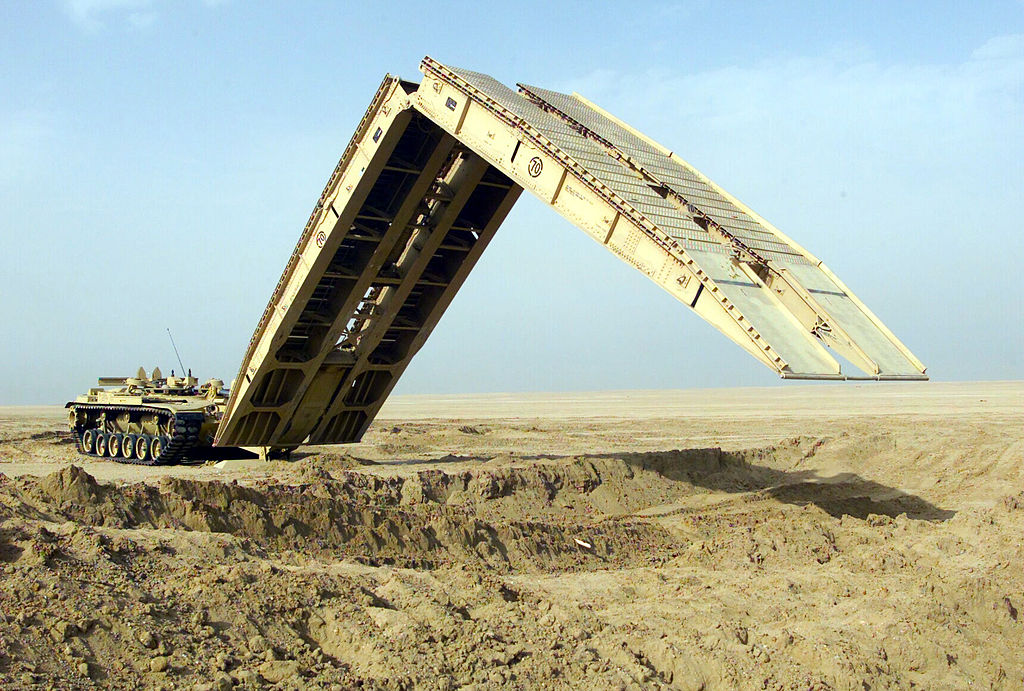
There are other tasks engineers can do on their turn: removing obstacles or debris (see below) for example. They can build command posts and engineer units get better odds in minefields. The list goes on. I have mentioned it before, I like it when different unit types differ also in their abilities and not only in their counter graphics.
This is the phase where you place your air units. That’s right, air units do not really move at this scale. You place them on the map where you want them to operate this turn.
And now it gets really interesting. In order to conduct an air strike you will have to plan it ahead of time. The scenario rules tell you how many air strikes you have, and at the beginning of the game you write down which air strike happens during which turn. During the air unit phase you will have to stick to those previously planned air strikes. This leads to a more realistic simulation. Your reaction to what happens on the board/map happens now on a finite time. More over by requiring planned air strikes game turns become entangled. They are less-discrete entities which should support the flow of the game.
In a similar fashion, indirect fire requires some foresight. Indirect Fire missions are planned one turn ahead of time. I’m really excited to see how this plays out during the game.
Nothing out of the ordinary here. Maybe I should mention here that game counters come with a ‘detected’ and an ‘undetected’ side. as long as units are on their undetected side, the opponent doesn’t know anything about the unit itself. I think this is a nice feature to represent the fog of war aspect.
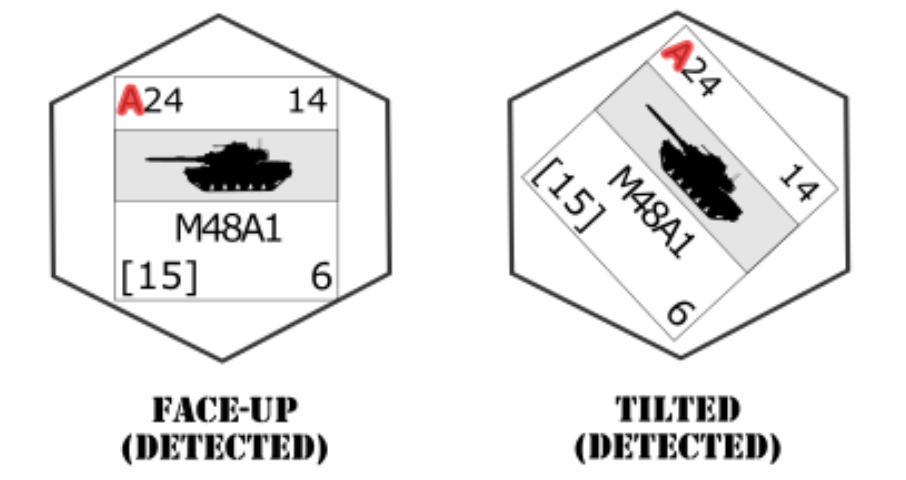
Something else that caught my attention are the stacking rules. Units come with stacking points. In the base rules you can never have more than four stacking points accumulated in one hex. This is not really unusual. However, a set of optional rules lets you assign stacking points to debris as well. Engineers can then be sent to remove debris stacking points to make a hex passable. A nice mechanic that I hadn’t seen before (remember: wargame noob). Those optional rules allow also to “overstack” a hex. Up to 25 stacking points can then be accumulated in one hex. This comes then for a price of penalties for the units in that hex.
If you have read any of the posts here on gringogamer you might know that I have a thing for supply rules. Imagine my reaction when I saw that Obscure Battles comes with supply rules. They are optional, so don’t worry if supply mechanics in wargames make you nervous.
So what exactly is meant by “supply check” at this scale? Well, there seems to be some bookkeeping involved, that’s for sure. But it looks like the mechanic is worth the extra effort: Each unit carries a combat load of ammunition, usually enough for a few turns. Before each attack the player needs to decide if the unit is going to spend 1, 2 or 3 turns worth of ammunition. More ammunition means a higher attack strength. You can replenish the ammunition via a supply dump close by or resupply vehicles. Obviously this rule only makes sense for low counter density battles. I really like this rule. I can see myself pondering over the ‘attack strength vs distance to next supply dum’ strategy.
Gringogamer: Since when are you working on the Obscure Battles System?
FREMAN GOLDBO: Obscure Battles was getting ready for the last decade – you know, taking notes and like. Reading about the topics and reading books about the wargaming itself. You can’t imagine how deep a subject this is – wargaming – just amazing. I remember reading and reading Perla’s book and saying Wow each time. But then again, I am Industrial Engineer myself and work in tech, so simulation and modeling is something that I learned and kept using in my job so I think it was always there – I was working on this all the time without thinking about it.
Around 2016, I had a spell of free time – something I don’t really have a lot – and started drawing the design scopes for the games that I wanted to do – what conflicts and how I wanted to “sim” them. Then every year, I filled in the details – the units, scenarios, etc.
It was 2019, I got really close to launching and had another spell of free time and also met my “partner-in-crime” so some titles were finalized.Lots of options and interactions. You know what works – and what doesn’t. Computer Wargames are very good – no doubt about that but wargaming on the board is a different thing. Each board game is a bit like this special burger joint on the corner that has its own taste … and sometimes its own smell from the printer 🙂
I am excited. I really want to play this game as soon as possible. For the last three months this seemed to be impossible, but now I might get the chance.
As mentioned above. If I get this game to the table soon I will modify Part II of the Obscure Battles (P)review accordingly.
Everybody stay safe!
Carsten
I still have no means to print and play the game. At least not without jumping trough some hoops. Print stores are still closed. Those that can’t afford to stay closed cater to families that are hunting for home schooling supplies (schools are also still closed). It’s a mess out there and I feel like me wanting to print that game is right now just unnecessary luxury.
At the same time the second part of the review is taunting me and I want to bring this to an end as promised. The original idea to write a preview instead of a review, somehow doesn’t feel right. The game is readily available and there’s nothing to preview. I made several attempts to write a second part but I wasn’t very happy with any of those.
With a heavy heart I have decided to pause the Obscure Battles article series until I really can play the game. It deserves this much attention. Anything else would not be fair.
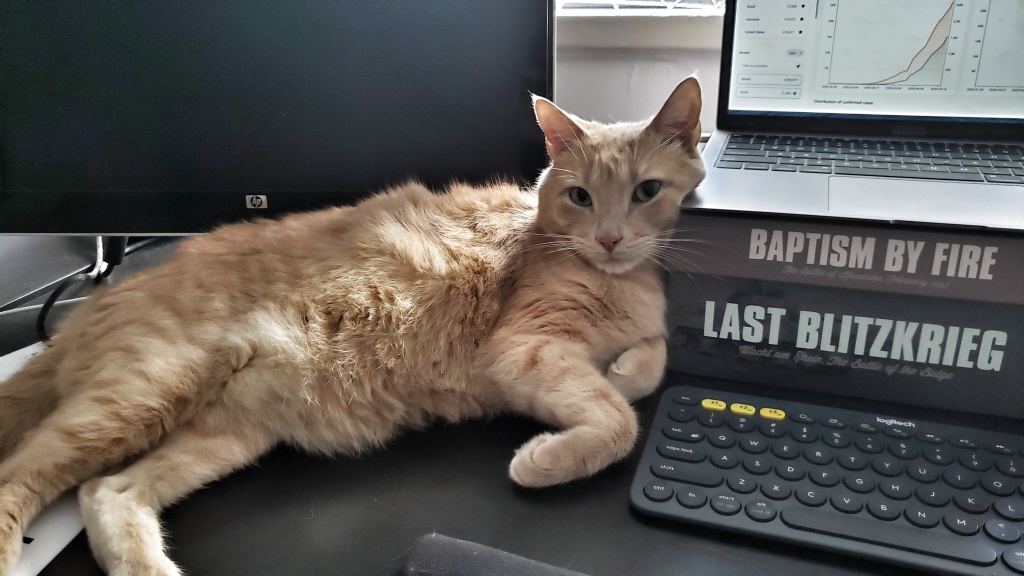
It’s been a little quieter here recently. I almost feel like I should apologize. But then I realize, we are all affected by COVID19 in one way or another. And in my case I just don’t have as much time for the things I like doing as I would like to have. But I’m still here, I’m still playing wargames and I intend writing about it.
Let’s continue with the introduction of Hurtgen: Hell’s Forest and the Grand Operational Simulation Series (GOSS).
We talked about Movement, Mode and Observation Rules, I showed you how the GOSS Logistics work, we had a very first taste of combat with Fire Support Description and then jumped into the Ground Assault Procedures (all GOSS articles). While those cover probably the big chunk of the rules, there are still some ‘smaller’ rules left we haven’t looked at yet. When I say ‘smaller’ I don’t mean ‘less important’. On the contrary, as we will see, those rules have a purpose and add flavor to the system. We start today by introducing Engineers and their capabilities.
I have mentioned it before. One of the things I like about Hurtgen: Hell’s Forest and GOSS in general, is that units of different types differ in more than just Movement Allowance and Attack/ Defense Factors. Recon units, in most games are simply smaller, weaker and maybe a little faster units without any particular purpose. In GOSS you can utilize their agility to ‘draw hits’. Artillery units do not just move. They need to change into movement mode and might even need to be transported. And so does every type of unit have a role to play. And engineers are no exception to this. We have mentioned engineers before and the benefits they provide during a Ground Assault on a fortified location. It probably shouldn’t be a big surprise to learn that there are more ways in which engineers can be useful. Here’s a little overview:
Engineers can ferry leg units across water obstacles. The amount of units that can be ferried depends on the amount of engineer steps available and the size of the river. GOSS distinguishes between four different water obstacles.
Each engineer step ferries one leg unit (of any size) across a stream. Obviously the engineers need to be adjacent to the hexside that’s being crossed. Movement penalties for leg units are reduced to zero when using a ferry across a stream.
The situation is identical to streams, but leg units will have to pay 1 movement point for the crossing.
The wider the river the more personpower is needed. In case of major rivers you need a complete unit (any size) to ferry a leg unit (any size). And while smaller waterways don’t restrict the starting hex of the unit being ferried, major rivers don’t allow for any additional movements prior or after the ferrying. The movement allowance is fully spent for the ferry.
Great Rivers can’t be crossed by ferries but require the construction of a bridge. (In Hurtgen: Hell’s Forest the Rhine is categorized as a Great River, whereas the Meuse River is considered a Major River.)
Now the principle mechanic behind building bridges is identical to the one used for ferrying troops: engineers need to be adjacent to the water obstacle they want to bridge. And the more engineer steps participate in the construction, the wider the river they can bridge in less time.
To give you some examples: one engineer step can build a bridge across a minor river within three Game Turns (GT), while three engineer steps can do the same job in just one GT. Use the bridge construction markers and the multi-purpose markers to keep track of the construction process. Should during the construction any of the involved engineer steps become fatigued, run out of supply or an enemy unit moves adjacent to it, the construction timer is reset.
Repairing a bridge follows the same procedure.

Engineers can of course build more than just bridges.
In GOSS Field Works is the collective term for Improved Positions (IP) and Entrenchments (ET). Each of these constructions comes in various levels indicating their strength: IP-1, ET-2, ET-3. Field Works do not necessarily require the present of engineers, any non-HQ/non-artillery unit will do, but engineers of course do a more efficient job.
So, two steps of regular units will finish an IP in the next friendly Construction Phase. The same can be achieved by a single engineer step. If you use two steps, one of which is an engineer step, the IP is completed at the end of the immediately following Movement Phase in the Quick Construction Segment.
ET-2 constructions follow the same procedure. However, ET-2 constructions must start with units unobserved by enemy units.
Construction and placement of ET-3 Field Works follows the instructions provided in the scenario rules.
If any construction work of Fieldworks is interrupted due to Ground Assaults, retreats or simply because the units ran out of supply, all prior work is lost.
Stronger Defensive Works like Forts and Fortified Areas can’t be constructed during a game. Scenario rules specify the placement of the former ones. The latter ones are printed map features like the West Wall in Hurtgen: Hell’s Forest.
As it was pointed out by Tyler on the GOSS page on Facebook, with the upcoming release of version 2.0 of the rules set engineers gain an additional ability: upgrading roads.
17.7.0 Road Improvement
Players may use Eng units to improve the quality of trails and roads for supply purposes only. Road improvement is temporary and only valid as long as the conditions apply. Important: Improved roads do not affect movement costs, nor do they confer any other benefit gained for the improved road.
Yet another reason to look forward to the iteration of the GOSS rules.
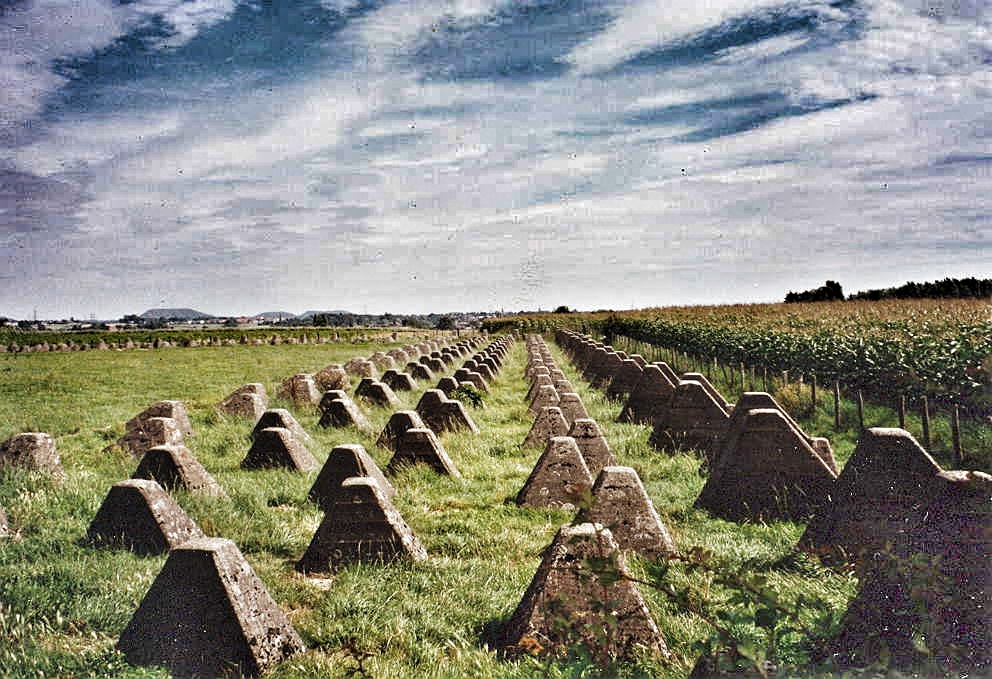
By now it should be obvious that engineers play a crucial role in the GOSS system. I kind of like the idea that engineers are not just counters with a different combat factors printed on them. Admittedly, I was taken aback a little by the amount of details and thought it’s a lot to digest. Not necessarily complicated stuff, but it’s easy to forget the various points. But I started making notes before each game turn. Similar to the Orders in Multiman Publishing’s Battalion Combat Series. Among the things I jot down is the assignment of engineers to various tasks. Not perfect, but it helps me quite a lot. The administrative overhead for this is miniscule.
We are almost done with the GOSS rules overview. Come back next time!
Stay safe!
Carsten
2020-05-02: Added a paragraph concerning engineers in the upcoming v2.0 of the GOSS rules. Thanks to Tyler for pointing this out!
I hope everybody is doing well! The situation in Brazil is tense, at least among the ones who are aware of what might be coming. On the plus side, I get to spend time with my family.
But enough of COVID-19! For the BCS players among you, Dean Essig is working on a version 2.0 of the rules. A beta version is available for download in the files section of BGG’s Last Blitzkrieg page. I will summarize all major changes in a future post.
Abraços,
Carsten
P.S. Everybody, stay safe!
Quick Covid-19 update from the Gringogamer household. I’m sorry, but it’s kind of the topic right now and I thought I should share this here as well. Mainly to get it off my chest.
Rio de Janeiro is in a state of ‘Heightened Alert’. Universities, schools, public places (like the National Parks) are closed, public gatherings are prohibited. My wife and I are in the fortunate position that we are able to work from home. And that’s where we are hunkered down right now. Unfortunately, the majority of the population has not understood the severity of the situation yet. Way too many people seem to think they are on vacation. People are still flocking to the beaches, bars and restaurants. And it’s not for a lack of information! I wouldn’t mind so much if those morons were just endangering themselves, but that’s not really the case, is it?
With the population density of Rio de Janeiro we are sitting here on a powder keg. Looking at the current infection numbers in Brazil, it seems that we are only a few weeks behind Italy. And I’m afraid that Brazil has not the capabilities to deal with a pandemic, especially when there are politicians who still try to sell to the public that the whole Corona virus thing is a hoax. The situation is really bleak.
So, the whole family is at home. I might be able to play a few games that I was waiting to play for quite some time. But our daily schedule is not really optimized yet. It’s not that I have never worked from home before, but rather the fact that we are all at home at the same time. And the distractions are abundant. I’m interested to hear how other people deal with the situation. I see so many posts on social media from boardgamers and I get the impression that all of the sudden they have more time at hand. Is this really the case? How is everybody balancing family and work when quarantined?
Anyways, despite the grim outlook we try to make the best out of it. We now have a scheduled family boardgame timeslot every day. Everybody stops what they are doing, electronic devices are turned off and no talk about work or school is allowed. Our family boardgames collection is still small but we will manage. Just got a new game the other day. Our FLGS is closed for regular business, but takes online orders and delivers via courier. We got Pandemic – Reign of Cthulhu. We chose it not because of Covid-19 but rather because we like Pandemic. Reign of Cthulhu is currently our go-to family boardgame (not necessarily age-appropriate for every child).
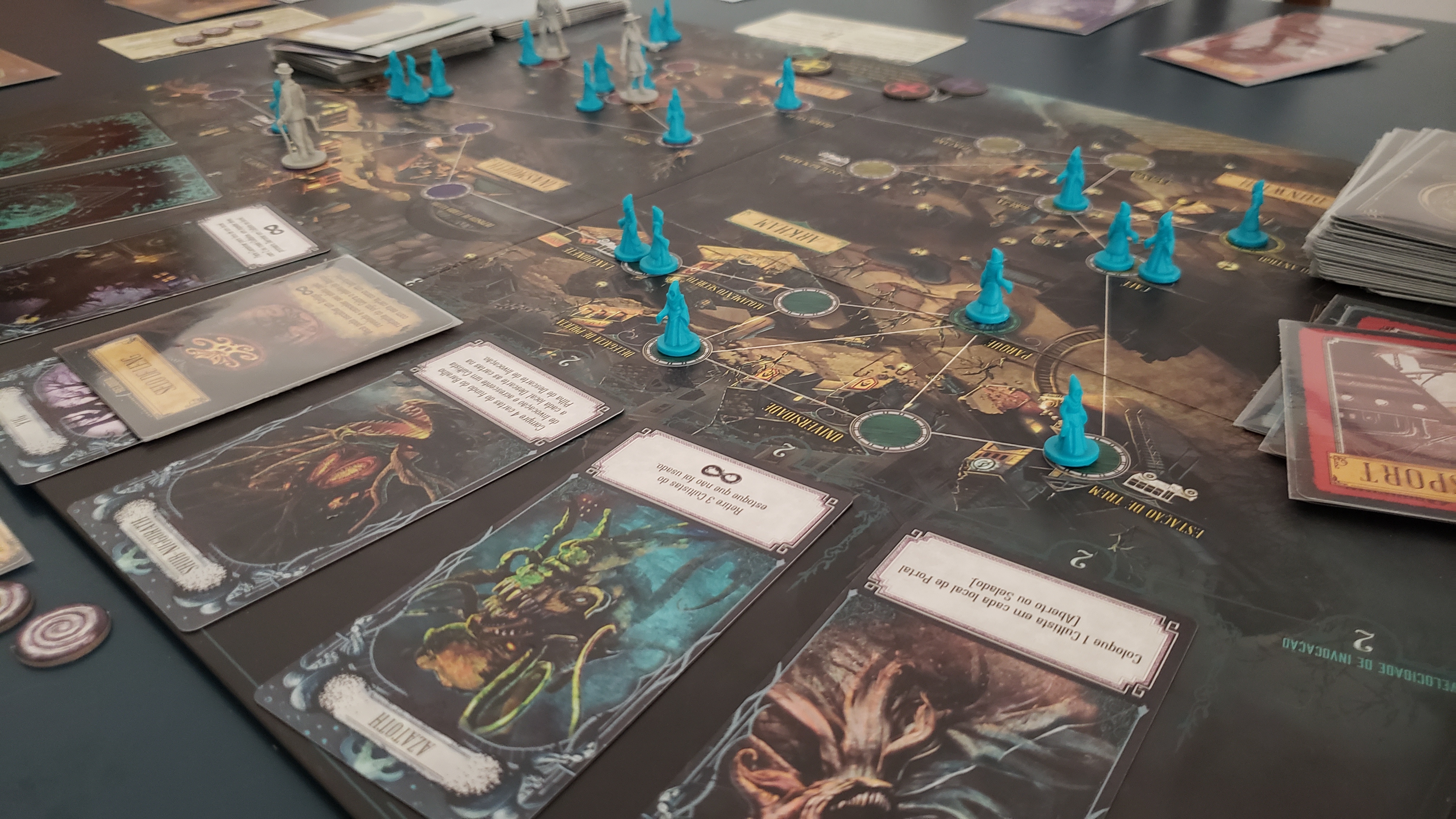
Playing Pandemic – Reign of Cthulhu with the family.
Yep, I guess that’s all wanted to say at this point. I hope you all stay safe! Please take care! Next post will be about wargames again. I promise!
Abraços,
Carsten
In an excellent post the RockyMountainNavy Gamer describes how he combines books and wargames to learn more about the Eastern Front in World War II. Inspired by the article I thought about how my reading habits have changed since I started playing wargames.
I always liked reading, but if you had asked me a couple of years ago, what kind of books I read, I would have answered ‘Mainly zero-brain-power-level-books!’. Never had it crossed my mind to read anything but fiction. This has changed. I wanted to know more about the conflicts that I was setting up on my table. And that almost automatically set off a feedback loop. I played a game, wanted to know more about it, read a book about the conflict, understood more what was going on, played the game again, saw how some of the rules are influenced by the historical events, wanted to know more,… You get the picture.
In the series Books and Wargames, I would like to talk about, well, books and wargames. I will pick a combination of one wargame and one book which worked for me very well. We start with Bernard Fall’s Hell in a Very Small Place and Kim Kanger’s Dien Bien Phu: The Final Gamble
Dien Bien Phu: The Final Gamble designed by Kim Kanger and published 2014 by Legion Wargames is a simulation of the final battle of the First Indochina War. French forces had occupied a valley close to the border to Laos. Relying on their superior artillery and being convinced that the valley could easily be supported by air, a total of 16000 French troops took on some 50000 Viet Minh communist revolutionaries. The battle started on March 13 with a heavy bombardment from the Viet Minh side. The strength and accuracy of which took the French by surprise. The original hope that the Vet Minh wouldn’t be able to sustain such an onslaught over a prolonged period of time was soon crushed. Over the course of the next two months the noose around the French position tightened and the battle eventually ended on May 7, 1954 with a French defeat.
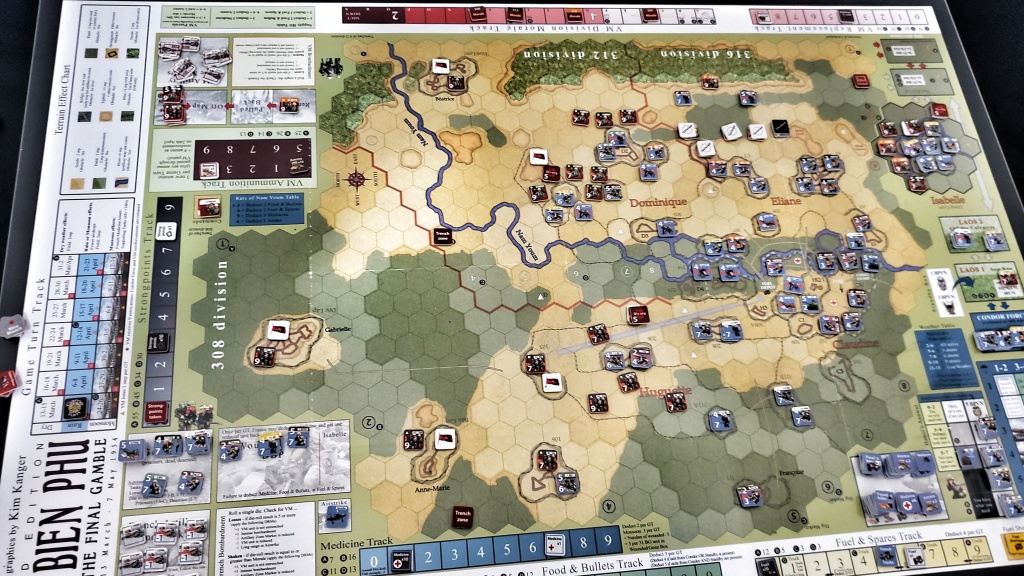
The game manages to capture the siege character of the battle in a brilliant way. Don’t be fooled to think it’s a rather static game. On the contrary, the constant back and forth with many important decisions to make on both sides makes for a very dramatic and tense gameplay:
On the French side you have to cover as much frontline as possible and make sure to reduce the unit density to mitigate artillery effects. Don’t get too attached to your strongholds. You won’t be able to hold on to all of them anyway. But do not let go of them without a fight either. Each lost stronghold will increase the Viet Minh trench system. And once the trenches are built, they will stay. Also, don’t let the Viet Minh troops get any rest for recover. So, do not just retreat to consolidate a smaller garrison. It also won’t take long before you will have to worry about supplies and replacements. Remember, everything has to be flown in and there are only so many planes available. Soon you have to pick between food, ammunition, medical supplies and reinforcements. You will be short of everything. A nerve-racking mini-game inside the actual game simulates how many and which of the planes eventually make the drop-off. And of course, there’s no place for you to go. You are surrounded by enemy troops, the landing strip is destroyed and the valley is too remote to hope for outside help other than the air drops.
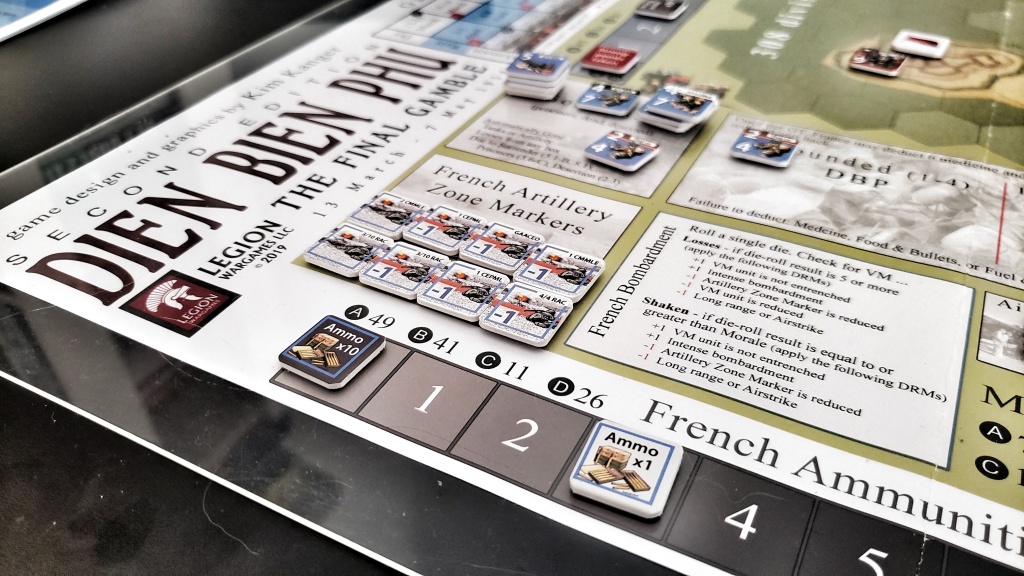
On the Viet Minh side you want to knock out the French artillery as soon as possible. While the French might have the better trained troops, the Viet Minh draws its strength from the sheer numbers of soldiers it has available. You won’t have the logistics to attack all French strongholds at the same time. But try to stretch out the French defensive line as far as possible. Don’t forget to advance the trench system. It offers additional cover for your infiltration attempts. Plus, the smaller the French fortified area, the larger your chance to pick up some of the ‘miss-dropped’ French supplies. Do not be too cautious. The Viet Minh expects constant progress. Failing to do so results in a loss of moral and with a reduced moral you won’t stand a chance against the French.
This is a fascinating game. And like wine or whisky (or Cachaça), it’s getting better over time. You will need at least a game to just get a picture of the inner workings of the game, of how the giant clockwork functions. And then you play it again and again and you start to wonder how the French should ever be able to win. It’s like a car crash that is supposed to happen and you can’t change anything about it. But then you start trying different strategies to defend the valley. And the attackers will come up with yet another diabolic plan for their siege. It is certainly interesting to play along the historic events, but the real challenge is probably to try your own ideas of how to attack/defend the valley. The possibilities are probably not endless but certainly enough to keep you busy for a long time.
Bernard Fall was born 1926 in Austria. His family migrated to France where he, as a 16 year old, joined the French resistance. He served in the French Army from 1944 until 1946.
After his service he studied in France, Germany and later the United States. In 1953 he went to Vietnam for his studies on Indochina. When he arrived, the Indochina War was in its seventh year. His French citizenship allowed Bernard Fall to accompany French troops and observe the conflict up close. Early on he predicted a French defeat.
After the war he continued covering Vietnam and returned several times. He supported the American military presence in Vietnam and his work was deemed very valuable for American diplomats.

Accompanying a company of the 1st Battalion 9th Marines Bernard Fall was killed on February 21, 1967 in the Thừa Thiên-Huế Province when he stepped on a Bouncing Betty.
Why read a book if you know what’s going to happen in the end? While this is certainly true for any whodunit, reading a historic account is of course different. You do so because you want to know what happens along the way. But there’s not just one way to tell a story. If you ask three different authors to describe a series of events, you probably end up with three different kinds of stories. On the other side you will find readers with different tastes. I prefer a book that finds a balance between statistics, situational analysis and interesting narrative. And Bernard Fall’s Hell in a Very Small Place is a perfect example of such a book.
Fall describes in his book the events in chronological order. Two recurring themes compete in the book. Early on Fall makes the point that according to engineering manuals, some 36000 tons of engineering materials were needed to fortify a garrison the size of Dien Bien Phu. But the lack of planes and time lead to the fact that French forces were eventually 30000 (!) tons short of engineering material. And throughout the siege the French forces should suffer from the almost non-existing air support. A constant shortage of ammunition, medical supplies and reinforcements would hunt the French command.
The other aspect that Fall understands brilliantly to convey is the constantly shrinking size of the French garrison. Detailed descriptions of the losses of the smaller strongholds, illustrated with a plethora of maps showing the siege at various stages leaves the reader with an almost claustrophobic feeling.
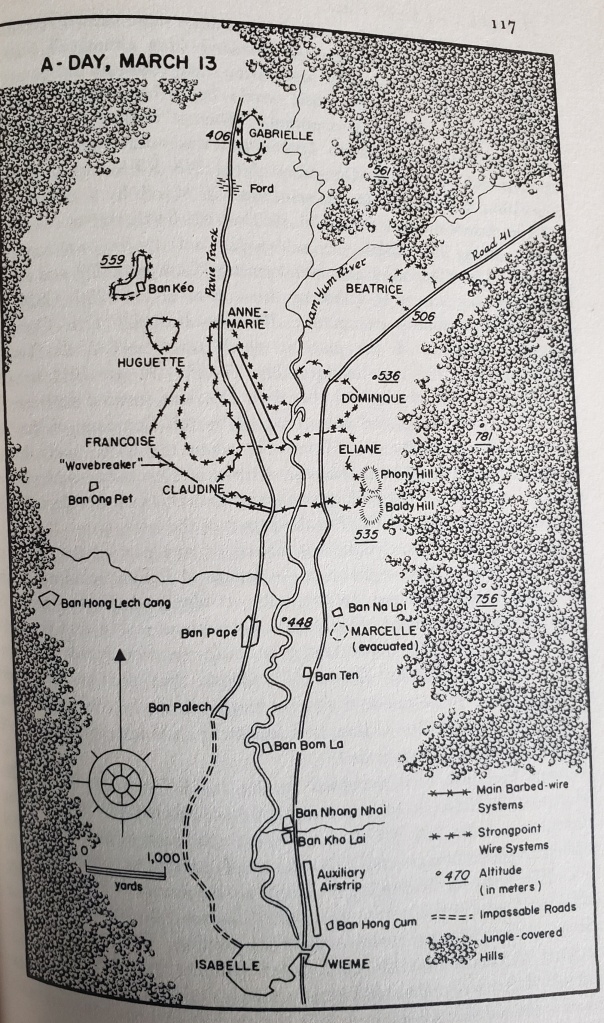

If you now have the impression that the book is just a sequence of dire accounts of military siege episodes you are mistaken. Fall leaves room for the humans in the conflict and their bravery and courage and their sometimes tragic-comically ordeals. And then you have to smile and remember that to some extend even that is part of Kanger’s game. Take a look at the French supply counters. Yes, they are just cardboard chits, but the choice of counter art is unique and it’s not an affront but rather a nod towards the French and their savoir-faire.

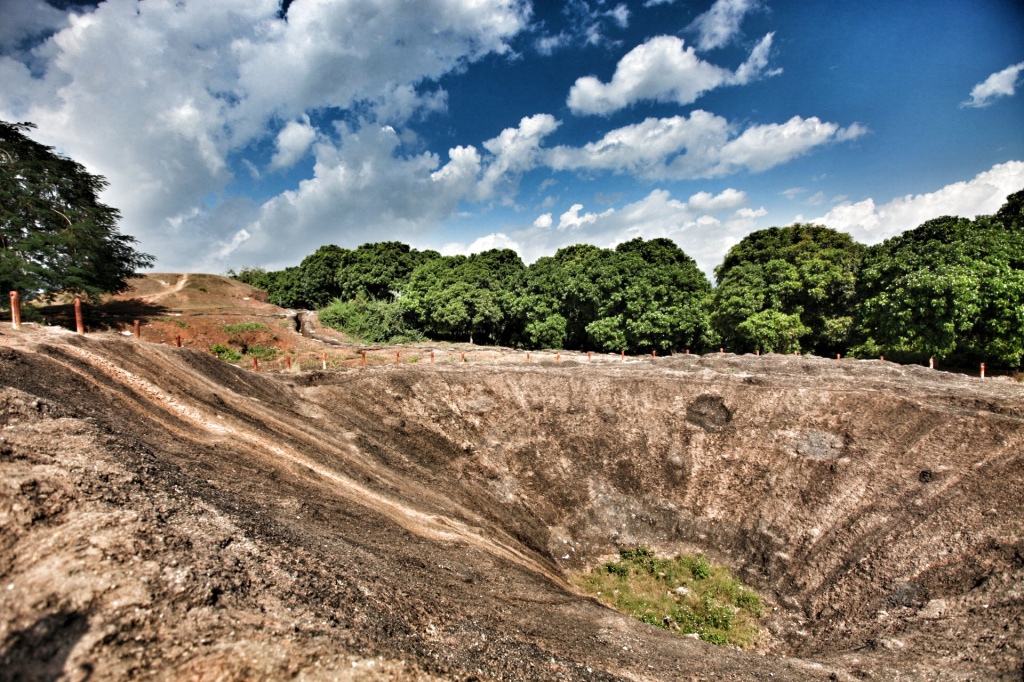
A few books have been written about the battle at Dien Bien Phu. Bernard Fall’s is surely the classic among them. Almost 54 years after its first publication the book doesn’t feel stale. On the contrary, you a sense for Fall’s intimacy with the conflict on almost every page. But this proximity comes for a price. Unlike more recent publications, Fall never had a chance to study the Viet Minh side of the conflict. He had to rely on the limited amount sources available to him. (If you are interested in a detailed description of immense logistical efforts that were undertaken by the Viet Minh,Valley Of The Shadow: The Siege Of Dien Bien Phu by Kevin M. Boylan and Luv Olivier might be a good starting point.)
You don’t need to read Fall’s book to play the Kanger’s game. Nor do you have to play the game when you just want to read the book. But the synergy that arises from combining both is amazing and probably appeals to every warmer or history buff. After reading the book I saw Kim Kanger’s depiction of the conflict with completely different eyes. I’m not sure whether initially I really appreciated the level of simulation the game offers. On the other side it was very immersive to break out the game while reading the book. Both, the game and the book have and always will have a special place on my shelf.
Abraços,
Carsten